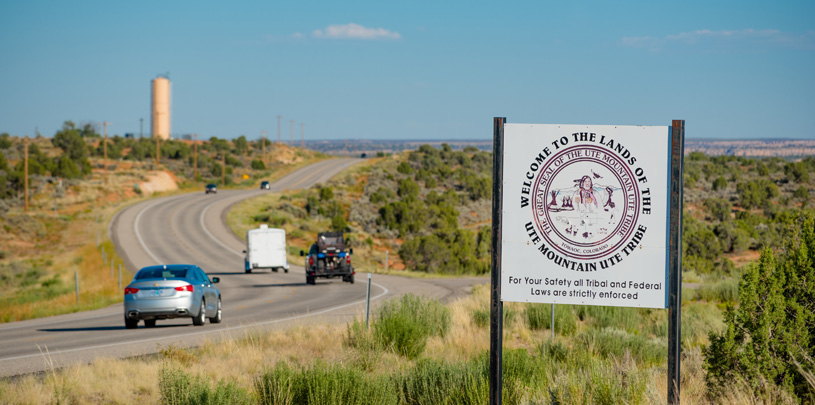
 by Tim Peterson, Cultural Landscapes Director
by Tim Peterson, Cultural Landscapes Director
What’s a uranium mill to do when global uranium prices tank? At the White Mesa Mill — on the doorstep of the Ute Mountain Ute Tribe’s White Mesa community and adjacent to the newly restored Bears Ears National Monument in southeastern Utah — the answer has been “get creative.”
Getting creative has meant going from paying for uranium ore to getting paid (between $5 and $15 million per year, says the mill's owner) to process and dispose of radioactive waste from polluters elsewhere.
Now, a new report and story map collection detail what waste streams the mill has sought to process, where they came from, and what discarded leftovers now simmer together in a toxic and radioactive stew in the mill’s massive waste pits.
The project tells the story of how this uranium mill on the edge of the Bears Ears cultural landscape became a low-cost radioactive waste disposal alternative.
Key takeaways from the report:
 The White Mesa Mill. DOM SMITH, ECOFLIGHT
The White Mesa Mill. DOM SMITH, ECOFLIGHT
Not long after opening in 1980, after only a few years of extracting uranium ore from rock and turning it into yellowcake (a precursor to nuclear power plant fuel), the mill began to look for ways to stay in business when uranium prices sank.
Soon the mill flipped its regular business model on its head. Instead of closing and cleaning up by the mid-1990s as originally planned, the owners of the White Mesa Mill have been charging fees to accept toxic and radioactive waste streams that contain uranium (called “alternate feed,” as an alternative to natural uranium ore) from contaminated military and industrial sites.
In order to dump the toxic and radioactive materials at the mill, federal and state regulators require that the mill first run the waste through the milling process to extract whatever uranium the waste contains. After that’s done, the rest (often more than 99 percent by volume) are discarded in the mill’s hundreds of acres of waste pits.
In this way, a uranium mill has become a player in the waste-disposal market with a budget edge over its competitors. The mill’s current owner claims it’s doing the world a service by “recycling” uranium from waste products, and that its operation provides “green jobs,” but the mill pollutes the air, land, and water.
 Members of the White Mesa community lead a spiritual walk to protest the White Mesa Mill. TIM PETERSON
Members of the White Mesa community lead a spiritual walk to protest the White Mesa Mill. TIM PETERSON
For decades, citizens of the Ute Mountain Ute Tribe’s White Mesa community, located a few miles down the highway from the mill, have opposed the mill’s radioactive waste disposal business. Some residents are afraid to drink the water, and some have stopped collecting plants and no longer hunt deer and rabbits near the mill. Trucks bound for the mill have spilled radioactive sludge along the highway that runs through the community.
A lot of people don’t understand what we go through here in our community. We want the mill to close. We want them to clean it up.
– Yolanda Badback, White Mesa Concerned Community
After years of legal challenges, in August 2021, the Ute Mountain Ute Tribe passed a Tribal Council resolution stating that “…the operations of the White Mesa Mill [have] had severe health impacts on the residents of White Mesa and should cease entirely…”
Until now, the issue of alternate-feed processing and disposal at the White Mesa Mill has flown under the radar. Renewed attention is focused on the region due to President Biden’s October 2021 restoration of Bears Ears National Monument. The restored monument’s boundaries lie just one mile west of the mill. This awareness, coupled with a call from the Ute Mountain Ute Tribe for the mill to cease operations, make it a good time to take a closer look at the mill’s radioactive waste disposal business.
The business of radioactive waste continues to extend the White Mesa Mill’s working life and to prolong the threats to air, water, land, wildlife, and communities nearby. Without alternate-feed processing, the mill owner’s CEO has said that “…the facility would probably have been reclaimed and wouldn’t be here.”
The White Mesa Mill is the U.S.’s last operating conventional uranium mill, but its operations are hardly conventional in the common sense of the word. A uranium processor is now acting like a waste disposal service. It’s time that law and regulation caught up with the mill’s business model. It should be regulated like the radioactive waste dump it has become.
Act now. Urge decision-makers to protect the Bears Ears cultural landscape from radioactive waste.
More than 275,000 pounds of radioactive materials imported from the Japan Atomic Energy Agency headed to Utah's White Mesa Mill.
Read MoreWhite Mesa Ute community leaders testify in Washington D.C. about how Utah's White Mesa uranium mill, near Bears Ears, affects their lives.
Read More"We want to have healthy lives. We want to have access to clean water," says Chairman Manuel Heart.
Read More